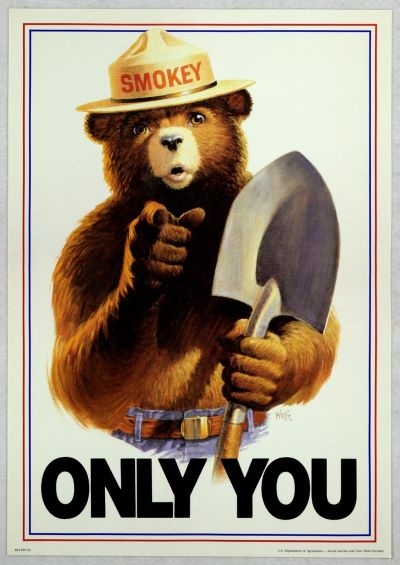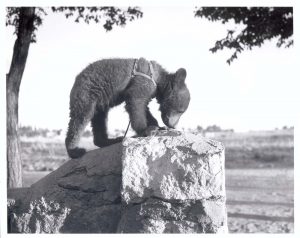A Voice in the Wilderness: After 75 Years, Smokey’s Message Still Looms Large

Courtesy of the U.S. Forest Service Smokey Bear collection, U.S. Department of Agriculture National Agricultural Library
One presence has stood tall spreading the word to prevent human-caused wildfires throughout the nation — Smokey Bear. For generations of Americans Smokey Bear and his message of “only you can prevent wildfires” has reminded us of the consequences of being careless with fire outdoors.
This past Aug. 9 marked 75 years that Smokey Bear has served as a national symbol for wildfire prevention — the longest running and most recognizable public service advertising campaign in U.S. history. The Ad Council, the U.S. Forest Service, and the National Association of State Foresters employ Smokey Bear to educate the public that carelessness with fire can cause destructive wildfires.
Smokey Bear’s full story starts a few years earlier.
In 1941 the U.S. Forest Service identified a need to prevent human-caused wildfires, as 208,000 fires that year burned 30 million acres of forest and rangeland throughout the nation. As the U.S. entered World War II, wood products were a critical commodity, and the loss of timber was especially damaging. Compounding the problem, as the war effort grew, a large portion of the able-bodied men who fought wildfires were called to military service, leaving our lands even more vulnerable.
The Forest Service would discover a mascot to deliver its prevention message — in Hollywood. In 1942, Walt Disney Studios released the animated film “Bambi”. An emotional scene in the movie depicts Bambi, his father, and other forest animals fleeing from a wildfire. Disney loaned the use of Bambi to the Forest Service for one year. The Bambi campaign was successful, the Forest Service began to search for their own character, and decided this time it should be a bear.
On August 9, 1944 the Forest Service unveiled a poster created by artist Albert Staehle depicting a new character — Smokey Bear — pouring water on a campfire. On this initial poster, Smokey says “Care will Prevent 9 out of 10 Fires.” In 1947 a new slogan was introduced: “Only YOU Can Prevent Forest Fires!” In 2001 this was changed to “only you can prevent wildfires” to encompass destructive wildfires that also occur in brush and grass fuel types.
Smokey Bear became instantly popular — and only a few years after the ad campaign started, he came to life! In 1950 a young bear found himself caught in the Capitan Gap Fire in Lincoln National Park in New Mexico. He took refuge in a tree, and though he survived, was left badly burned. A forest ranger rescued the bear and named his Smokey. News about the injured bear cub spread across the nation. After he was nursed back to health, Smokey was given a home at the National Zoo in Washington, DC, where he would stay the rest of his life. Now a living icon, Smokey made the wildfire prevention message even more relatable to generations of Americans. The real-life Smokey died in 1976 and was returned home to Capitan, New Mexico, where he is buried in a state park, now known as Smokey Bear Historical Park.
Smokey’s image continues to serve as the recognizable face of forest and wildfire prevention. Throughout the years, the Maryland Forest Service has been proud to present Smokey Bear and his message at educational presentations, fire department functions, major and minor league baseball games, community safety events, and at our state parks. Smokey lives on as a reminder about the real consequences of either playing with or being careless with fire in the outdoors.
 Where There’s Smokey, There’s ‘Firewise’
Where There’s Smokey, There’s ‘Firewise’
In Maryland, forests and natural cover areas — grass, brush, and agricultural fields — are most susceptible to wildfire during spring and fall. In an average year, the Maryland Department of Natural Resources responds to 325 wildfires that burns 3,200 aces within the state.
Of those wildfires 97 percent are human caused — by improper debris burning, arson, children playing with fire, smoking, and campfires. Wildfires have the potential to kill trees, destroy wildlife habitat, and endanger homes.
Spring fire season occurs from mid-February through the end of May. During this time of year vegetation is dead or dormant from cold temperatures and frost. The lack of leaves on the trees allows radiant heat from the sun and wind to reach the forest floor. These conditions and warming spring temperatures quickly dries dead vegetation, leaves, and woody debris allowing them to burn readily.
Our second fire season is our “fall fire season” when the trees begin to go dormant for the winter and their leaves die, dry out, and fall to the ground. This blankets the forest in a fresh, fluffy, highly flammable bed of leaves.
In Maryland’s diverse regions, we always have the potential for wildfires during the summer and winter if drought conditions or unseasonably warm temperatures exist. Windy days and steep terrain compounds fire danger throughout the year.
The zone where human development is mixed with forests and other natural vegetation cover areas is known as the ”Wildland Urban Interface,” which represents an increasingly large area of Maryland. In this zone, firefighters must contend with multiple hazards and control issues while conducting fire suppression actions. Sadly some of those fires have not only destroyed natural resources and homes, but also claimed human lives of both citizens and firefighters.
The Maryland Department of Natural Resources Forest Service has a program called “Firewise Maryland” that is intended to educate homeowners on the steps they can take to maintain their home and area surrounding their home to aid in withstanding wildfires.
More Information on wildfire in Maryland programs to combat them can be found at dnr.maryland.gov/forests/Pages/wfm.aspx
Shannon Wolfe is the wildfire programs coordinator for the Maryland Department of Natural Resources Forest Service. Appears in Vol. 22, No. 4 of the Maryland Natural Resource magazine, fall 2019.



 1-888-373-7888
1-888-373-7888 233733
233733